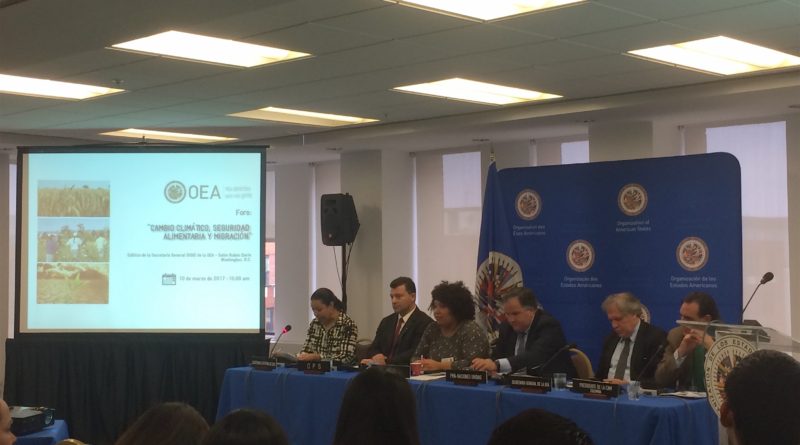Climate Change, Food Security and Migration in the Northern Triangle
Article and photo by Tyler Ferdinand
The Organization of American States (OAS) recently (3/7/17) hosted a panelist discussion on the nexus of climate change, food security and migration. Panelists included experts in the fields of migration, sustainable development, human security, water resources and rights and equity.
The topic of conversation centered on the current trends in migration from Central America and the reasons for migration related to climate change and food security. The particular area of concern is known as the Northern Triangle, which includes Guatemala, Honduras and El Salvador. This region incorporates the “dry corridor”, an area of Central America prone to drought along with other natural disasters including hurricanes. The Northern Triangle is currently experiencing one of the worst droughts of the last ten years with 3.5 million in need of humanitarian assistance.1 The drought has proved detrimental to small-scale agriculturalists and rural communities with important effects on food stocks, dietary diversity and malnutrition. In many cases, agricultural communities rely on a sole harvest and with increasing climate variability due to climate change, the security of this harvest is at high risk. Lack of subsistence and growing economic instability has led to staggering rates of migration within vulnerable communities. A 2015 exploratory study by the World Food Programme (WFP) found that 11% of families in Honduras had at least one family member that had emigrated for reasons related to food security.2
An interesting paradox was highlighted during the discussion concerning rural migrants who move into urban areas. Although climate change may be enhancing food insecurity in the sense of hunger in rural settings, through migration to urban areas it is also contributing to food insecurity in the sense of malnutrition. A growing number of the rural poor have transitioned to cities in the hope of finding steady income and have taken up diets high in fats and sugars and low in micronutrients. Obesity in the Northern Triangle has been estimated at 47% of the population despite issues with hunger.2
When discussing potential solutions to food insecurity in the region an emphasis was placed on the right to health, agricultural adaptation and social cohesion. Panelists highlighted the need for universal access to health care and inclusive health policies, education regarding climate variability and adaptive agricultural practices and policies that promote social cohesion between immigrant populations and locals.
The general sentiment at the discussion was that this issue has potential to escalate as the climate becomes more variable and the topic still requires a substantial amount of exploratory research.
1FAO (2016) Drought in the Dry Corridor of Central America. Food and Agriculture Organization of the United Nations. Available from: http://www.fao.org/emergencies/crisis/dry-corridor/en/.
2 World Food Programme (2015) Hunger Without Borders: The hidden link between Food Insecurity, Violence and Migration in the Northern Triangle of Central America. WFP. Available from: http://documents.wfp.org/stellent/groups/public/documents/liaison_offices/wfp277544.pdf?_ga=1.247067335.233971217.1489329780.

